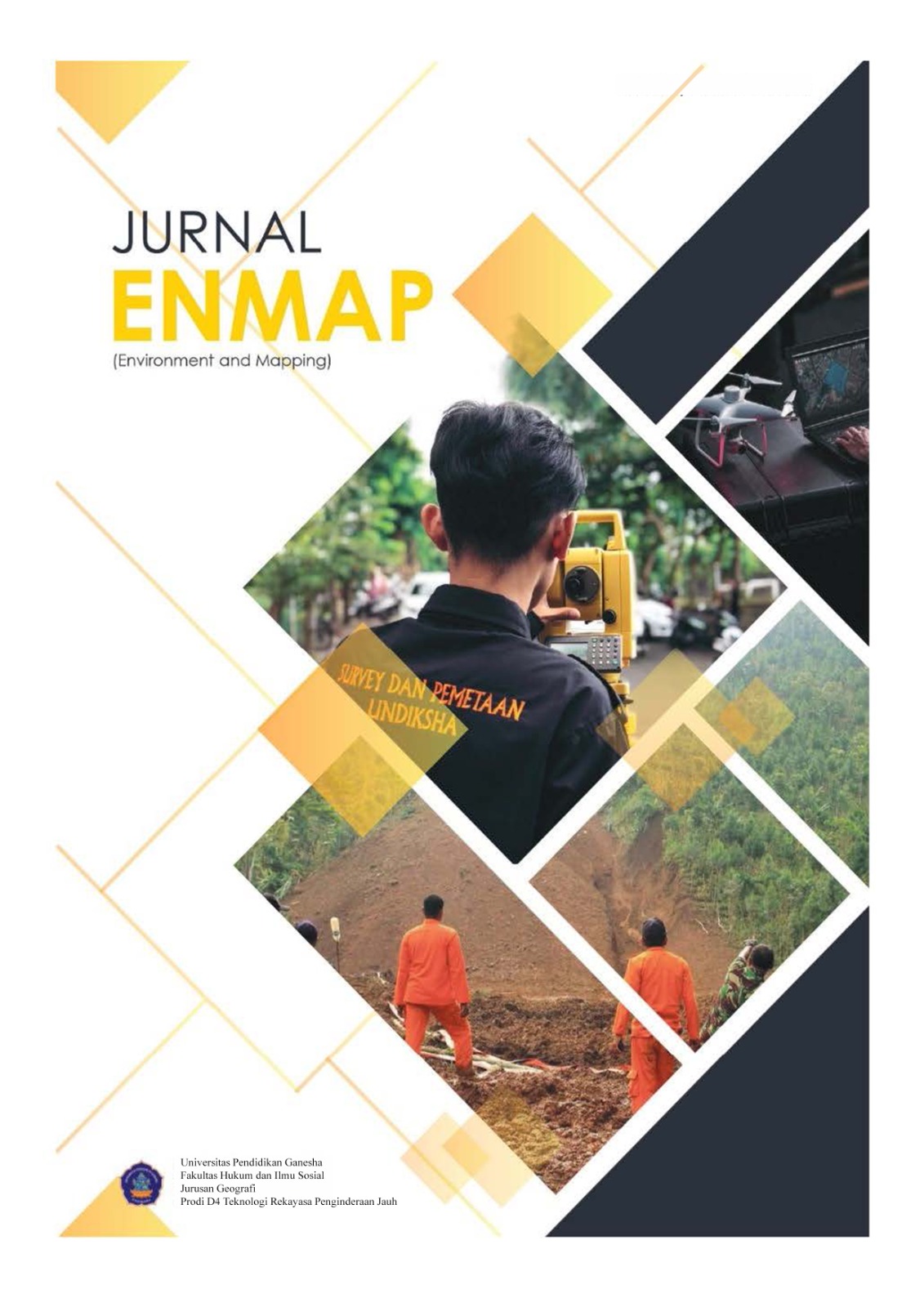PEMETAAN PENGGUNAAN LAHAN BERBASIS CITRA FOTO UAV (Unmanned Aerial Vehicle) DI KELURAHAN PENRUKAN KABUPATEN BULELENG
DOI:
https://doi.org/10.23887/enmap.v5i2.82551Keywords:
Pemetaan Penggunaan Lahan, Interpretasi VisualAbstract
The increase in the number of people from year to year will certainly increase the need for land which currently, land conversion has been rampant from agricultural land to built land. Looking at the situstion that occurred in Penarukan Village, Buleleng Regency, where several agricultural lands have been converted into land for development. Therefore, mapping the use of moors, rice fields plantations and settlements is very necessary to interpret land use from UAV photos which aims to obtain up to date data that includes the distribution and area of land use. This research will use a visual interpretation elements which will be done manually, namely through on-screen digitization in ArcGIS software, Ground Check, and Interpretation Accuracy Test The results obtained from this study are the visualization of the distribution of land use from moorland by showing the distribution pattern randomly while the plantation visualization of the distribution pattern was spread evenly, and from residential land which followed the pattern of secondary transportation road, collectors and arteries while the visualization of the distribution of rice field land use where this rice field land is the most dominant land use others, with a total percentage of 45.38% with the visualization of the distribution pattern scattered randomly. The results of the classification of land use classes obtained 21 classes of land use which include Irrigation fields, Residential Houses, Mixed Gadens, Temples, Hotels, Sports Facilities, Educational Facilities, Fuel Pump Stations, Mosques, Bank Offices, Gardens, Housing, Tegalan, Stations/Terminals, Traditional Trade Centers and Health Centers. The area of the entire land use class of Penarukan village is 373.04 Ha. The accuracy level of the percentage of interpretation test results obtained is 100% based on verification of the 30 sampel points used.
References
BPS. (2024). jumlah kependudukan 2019-2023. Badan Pusat Statistik Kabupaten Buleleng. https://bulelengkab.bps.go.id/publication/2023/12/08/cba9470cea36c9656ca5d8e5/analisis-hasil-survei-kebutuhan-data-bps-kabupaten-buleleng-2023.html
DLH. (2024). Bank Data Kecamatan Buleleng. Dinas Lingkungan Hidup. https://www.google.com/search?q=bank+data+kecamatan+buleleng&oq=bank+data+kecamatan+buleleng&gs_lcrp=EgZjaHJvbWUyBggAEEUYOTIGCAEQRRg8MgYIAhBFGDwyBggDEEUYPNIBCTE3NjM2ajBqN6gCALACAA&sourceid=chrome&ie=UTF-8
Geosfer, J. P., Rauzan, M., Yulianti, F., & Lahan, P. (2022). Pemanfaatan Drone Untuk Identifikasi Penggunaan. Jurnal Pendidikan Geosfer Volume VII Nomor 1 Tahun 2022, VII, 105–113. https://doi.org/10.24815/jpg.v
Ikhwan, M., Tri Ratnaningsih, A., Lestari, I., & Ikhsani, H. (2021). Aplikasi Teknologi Unmanned Aerial Vehicle (Uav) Untuk Mengidentifikasi Tutupan Hutan Dan Lahan Di Universitas Lancang Kuning. Wahana Forestra: Jurnal Kehutanan, 16(1), 86–101. https://doi.org/10.31849/forestra.v16i1.5393
Putri, N., & Sugito, N. T. (2023). Analisis Efektivitas Metode Digitasi On-Screen dan Object-Based Image Analysis ( OBIA ) Melalui Foto Udara dalam Pemetaan Bidang Tanah Kawasan Permukiman ( Studi Kasus di Desa Ciwaruga , Kecamatan Parongpong , Kabupaten Bandung Barat ) Pendahuluan Kebutuh. 19(1), 73–87.
Tahir, A. (2024). Interpretasi Foto Udara untuk Identifikasi Ekosistem Pantai. Penelitian Pendidikan Geografi, 9(1), 52–62.
Wahyu Aji Nugroho. (2020). Analisis Penyusutan Lahan Sawah Di Kecamatan Purwokerto Selatan Tahun 2005 - 2017. 1301010039, i–41.
Zalmita, N., Alvira, Y., & Furqan, M. H. (2020). Analisis Perubahan Penggunaan Lahan Menggunakan Sistem Informasi Geografis (Sig) Di Gampong Alue Naga Kecamatan Syiah Kuala Tahun 2004-2019. Jurnal Geografi, 9(1), 1. https://doi.org/10.24036/geografi/vol9-iss1/920
Downloads
Published
How to Cite
Issue
Section
License
Copyright (c) 2025 made, I Gede Yudiwisnawa, I Wayan Treman

This work is licensed under a Creative Commons Attribution-ShareAlike 4.0 International License.
Authors who publish with the Jurnal ENMAP agree to the following terms:
- Authors retain copyright and grant the journal the right of first publication with the work simultaneously licensed under a Creative Commons Attribution License (CC BY-SA 4.0) that allows others to share the work with an acknowledgment of the work's authorship and initial publication in this journal.
- Authors are able to enter into separate, additional contractual arrangements for the non-exclusive distribution of the journal's published version of the work (e.g., post it to an institutional repository or publish it in a book), with an acknowledgment of its initial publication in this journal.
- Authors are permitted and encouraged to post their work online (e.g., in institutional repositories or on their website) prior to and during the submission process, as it can lead to productive exchanges, as well as earlier and greater citation of published work. (See The Effect of Open Access)







